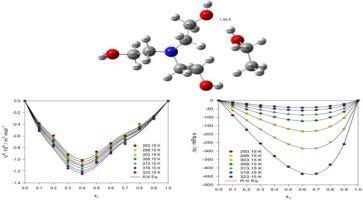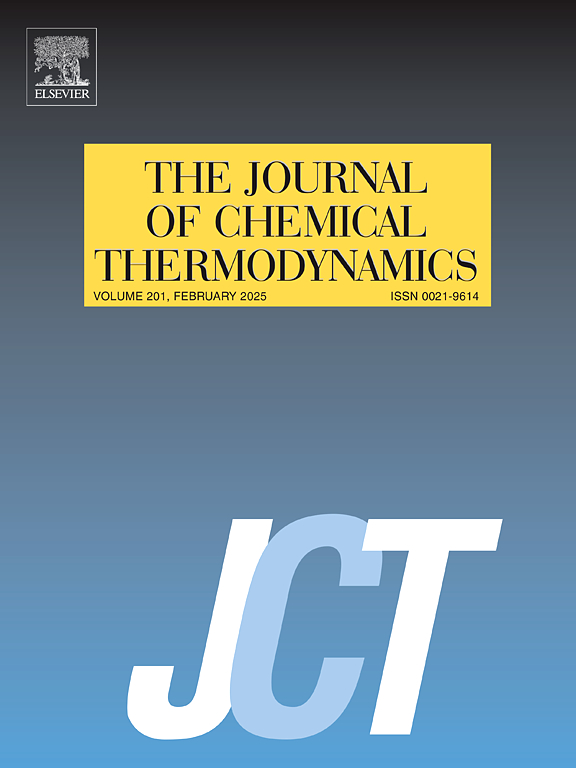Experimental and computational (DFT) study of a binary system of triethanolamine and ethanol at temperatures from 293.15 to 323.15 K under 101.3 kPa
IF 2.2
3区 工程技术
Q3 CHEMISTRY, PHYSICAL
引用次数: 0
Abstract
In this study, the density and viscosity of binary mixtures of triethanolamine (TEA) and ethanol were measured over the entire composition range at temperatures of 293.15 and 323.15 K under a pressure of 101.3 kPa. Correlations were obtained expressing density and viscosity values as a function of temperature. Excess molar volume (VE) and viscosity deviation (Δη) were calculated from the measured values. These properties were further fitted to the Redlich–Kister polynomial equation. Thermodynamic parameters such as partial molar volumes, apparent molar volumes, coefficients of thermal expansion, and excess Gibbs free energy of activation for viscous flow were also determined. Moreover, activation enthalpy and entropy values for viscous flow were evaluated. The experimental results and the Density Functional Theory (DFT) calculations were used to discuss the molecular interactions for binary mixtures of TEA and ethanol. Negative values of VE and Δη were observed across all studied temperatures and compositions, indicating strong specific interactions between TEA and ethanol molecules. There is a distinct difference in the temperature dependence of VE and Δη. As the temperature increases, the VE values become increasingly negative, while the Δη values decrease. Both experimental results and Density Functional Theory (DFT) calculations confirm the presence of intermolecular hydrogen bonding in the binary mixtures. Furthermore, FTIR spectroscopy suggests the possible presence of intermolecular interactions between the components.

温度293.15 ~ 323.15 K, 101.3 kPa下三乙醇胺和乙醇二元体系的实验和计算研究
在本研究中,在温度为293.15和323.15 K、压力为101.3 kPa的条件下,测量了三乙醇胺(TEA)和乙醇二元混合物在整个组成范围内的密度和粘度。得到了表示密度和粘度值作为温度函数的相关性。根据测量值计算多余摩尔体积(VE)和粘度偏差(Δη)。这些性质进一步拟合到Redlich-Kister多项式方程中。热力学参数如偏摩尔体积、表观摩尔体积、热膨胀系数和黏性流动的过量吉布斯激活能也被确定。此外,还计算了粘性流动的激活焓和熵值。利用实验结果和密度泛函理论(DFT)计算,讨论了TEA和乙醇二元混合物的分子相互作用。在所有研究温度和成分中,均观察到VE和Δη为负值,表明TEA与乙醇分子之间存在很强的特异性相互作用。VE和Δη的温度依赖性有明显差异。随着温度的升高,VE值逐渐趋于负,Δη值逐渐减小。实验结果和密度泛函理论(DFT)计算都证实了二元混合物中存在分子间氢键。此外,FTIR光谱分析表明,组分之间可能存在分子间相互作用。
本文章由计算机程序翻译,如有差异,请以英文原文为准。
求助全文
约1分钟内获得全文
求助全文
来源期刊

Journal of Chemical Thermodynamics
工程技术-热力学
CiteScore
5.60
自引率
15.40%
发文量
199
审稿时长
79 days
期刊介绍:
The Journal of Chemical Thermodynamics exists primarily for dissemination of significant new knowledge in experimental equilibrium thermodynamics and transport properties of chemical systems. The defining attributes of The Journal are the quality and relevance of the papers published.
The Journal publishes work relating to gases, liquids, solids, polymers, mixtures, solutions and interfaces. Studies on systems with variability, such as biological or bio-based materials, gas hydrates, among others, will also be considered provided these are well characterized and reproducible where possible. Experimental methods should be described in sufficient detail to allow critical assessment of the accuracy claimed.
Authors are encouraged to provide physical or chemical interpretations of the results. Articles can contain modelling sections providing representations of data or molecular insights into the properties or transformations studied. Theoretical papers on chemical thermodynamics using molecular theory or modelling are also considered.
The Journal welcomes review articles in the field of chemical thermodynamics but prospective authors should first consult one of the Editors concerning the suitability of the proposed review.
Contributions of a routine nature or reporting on uncharacterised materials are not accepted.
 求助内容:
求助内容: 应助结果提醒方式:
应助结果提醒方式:


